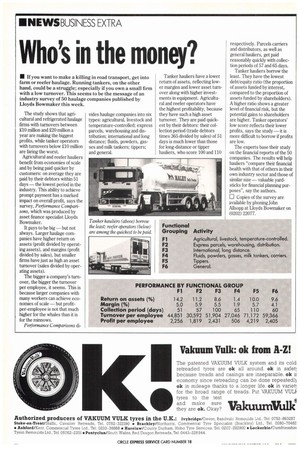Who's in the money?
Page 20

If you've noticed an error in this article please click here to report it so we can fix it.
• If you want to make a killing in road transport, get into farm or reefer haulage. Running tankers, on the other hand, could be a struggle; especially if you own a small firm with a low turnover. This seems to be the message Man industry survey of 50 haulage companies published by Lloyds Bowmaker this week.
The study shows that agricultural and refrigerated haulage firms with turnovers between .210 million and £20 million a year are making the biggest profits, while tanker operators with turnovers below £10 million are faring the worst.
Agricultural and reefer hauliers benefit from economies of scale and by being paid quicker by customers: on average they are paid by their debtors within 51 days — the lowest period in the industry. This ability to achieve prompt payment has a marked impact on overall profit, says the survey, Performance Comparisons, which was produced by asset finance specialist Lloyds Bowrnaker.
It pays to be big— but not always. Larger haulage companies have higher return on assets (profit divided by operating assets), and margins (profit divided by sales), but smaller firms have just as high an asset turnover (sales divided by operating assets).
The bigger a company's turnover, the bigger the turnover per employee, it seems. This is because larger companies with many workers can achieve economies of scale — but profitper-employee is not that much higher for the whales than it is for the minnows.
Performance Comparisons di vides haulage companies into six types: agricultural, livestock and temperature-controlled; express parcels, warehousing and distribution; international and long distance; fluids, powders, gasses and milk tankers; tippers; and general.
Tanker hauliers have a lower return of assets, reflecting lower margins and lower asset turnover along with higher investments in equipment. Agricultural and reefer operators have the highest profitability, because they have such a high asset turnover. They are paid quickest by their debtors: their collection period (trade debtors times 365 divided by sales) of 51 days is much lower than those for long-distance or tipper hauliers, who score 100 and 110 respectively. Parcels carriers and distributors, as well as general hauliers, get paid reasonably quickly with collection periods of 57 and 65 days.
Tanker hauliers borrow the least. They have the lowest debt/equity ratio (the proportion of assets funded by interest, compared to the proportion of assets funded by shareholders). A higher ratio shows a greater level of financial risk, but the potential gains to shareholders are higher. Tanker operators' low score reflects their lower profits, says the study — it is more difficult to borrow if profits are low.
The experts base their study on the financial reports of the 50 companies. The results will help hauliers "compare their financial health with that of others in their own industry sector and those of similar size — valuable yardsticks for financial planning purposes", say the authors.
Copies of the survey are available by phoningJohn Allsopp at Lloyds Bowmaker on (0202) 22077.
























































































































































